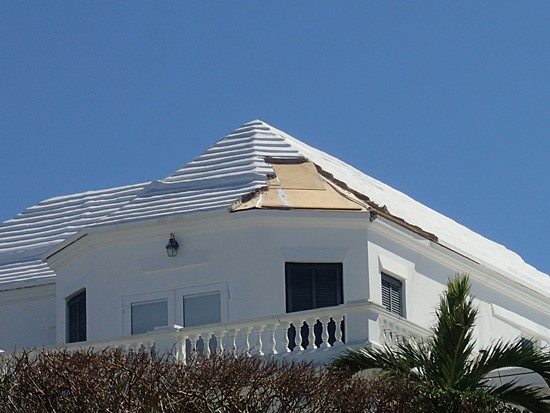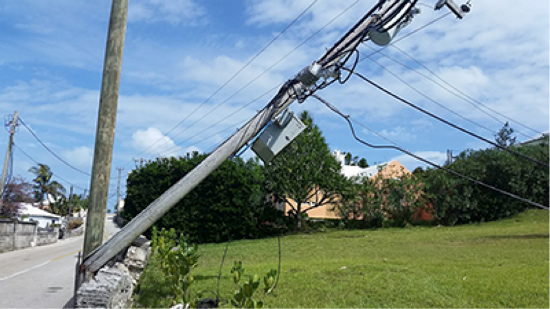Hurricane Gonzalo
Status: Closed
Landfall | Summary
Posting Date: October 19, 2014, 6:00:00 AM
Storm Impacts
On Friday October 17, at 8:30 PM AST, the very center of Hurricane Gonzalo made landfall on the south-central coast of Bermuda. Bermuda literally passed through the eye of the needle; with an eye diameter twice the length of Bermuda, webcams on the island recorded an eerie calm for about 90 minutes before strong winds, coming this time from the opposite (westerly) direction, moved in once again.
When the eye began to come onshore, the storm was still Category 3 with 115 mph winds, but by the time the very center passed overhead, Gonzalo had weakened to Category 2, with 110 mph winds.
The strongest observed winds at the Bermuda airport were 93 mph sustained, gusting to 113 mph. A station at nearly 300 feet above sea level in Commissioner's Point reported a gust of 144 mph; however, it should be noted that winds at this elevation can be up to 30% higher than locations at sea level.
The storm weakened prior to landfall due to both lower sea surface temperatures and higher wind shear in the vicinity of Bermuda. Note that the center of Tropical Storm Fay passed directly over the island less than a week ago. It is likely that Fay’s passage reduced the sea surface temperatures around Bermuda and allowed Gonzalo to be just slightly weaker than it might have been.
Trivia of the day: Gonzalo is just the third recorded Cat 2 or above storm to pass directly over the island of Bermuda since NOAA’s official hurricane database, HURDAT, began in 1851. The other storms were in 1895 and 1922. Hurricane Fabian's track was just west of the island in 2003, and the center did not pass directly overhead.
The observed winds from Gonzalo were a bit lower than Fabian’s, which caused about USD 300 million of loss in 2003 dollars; AIR estimates that a recurrence of Fabian today would cost the industry around USD 650 million.
Reported Damage
Buildings in Bermuda are designed to withstand sustained wind speeds up to 110 mph and gusts up to 150 mph. The codes are strictly enforced. It is not surprising, therefore, that reports of significant structural damage from Gonzalo in Bermuda are relatively scarce. Exceptions include an old recycling plant constructed of light metal and isolated instances of collapsed masonry walls.
Damage may also have been mitigated by the very fact that the very large—and very calm—eye of Gonzalo passed over Bermuda, which reduced the total number of hours of significant winds. (Look for more on this in an upcoming In Focus blog post.) Nevertheless, roof damage—ranging from a few blown off tiles to, in some cases, loss of nearly the entire roof—is fairly widespread. Roofs in Bermuda are typically made of limestone tiles cemented together. When tiles blow off, some damage to interior walls and finishes, as well as to contents is likely to result. Among the more notable buildings that sustained roof damage are the House of Assembly, the police headquarters, the Visitor Centre in St. Georges, and the hospital (both the old and new wings). Damage was also sustained at the Bermuda Aquarium, Museum and Zoo, where the sheet metal roof of an exhibit hall was torn off.

Typical roof damage pattern seen on Bermuda’s residential property. (Source: AIR)
The first reports of damage when daylight arrived on Saturday morning were dominated by downed trees and utility poles, which made roads impassable. According to the Bermuda Electric Light Company, or Belco, Gonzalo left 31,700 households in the dark. As of Saturday evening, just over 13,000 remained without electricity, but this figure includes approximately 1,500 customers that were still without power from Tropical Storm Fay’s passage over the island less than a week earlier.
 |
Snapped utility pole in St. George’s. (Source: AIR) |
Bermuda’s Causeway, which links Hamilton Parish on the mainland with the Bermuda International Airport in St. George's Parish, appears to have been left largely intact by Gonzalo, although several sections of concrete block wall had been knocked down by high waves. Divers have been dispatched to check for damage below water, but the Causeway is currently open to one-way traffic. Hurricane Fabian, which struck Bermuda in 2003, caused major damage to the Causeway, resulting in the loss of four lives. Fabian remains the strongest storm to impact Bermuda in 50 years. No fatalities have been reported from Gonzalo’s impact in Bermuda.
High waves from Gonzalo also tossed about sailboats and yachts, tearing some away from their moorings and forcing them ashore, and sinking others. Coastal erosion has also been reported along the island's south coast.
Meanwhile, clean-up is well underway. Crews have been clearing roads of debris since daybreak yesterday and LF Wade International Airport, which sustained some damage to its roof and partial loss of runway edge and approach lighting, is set to reopen for normal operations at 5:00 PM AST today.
An excellent photo gallery of damage can be found on the Bernews site here: http://bernews.com/2014/10/photos-morning-hurricane-gonzalo/
Footage from the Royal Gazette’s damage survey can be found here: https://www.youtube.com/watch?v=fW6QEL8PcG8
Current Situation
The center of Gonzalo remained well offshore of Newfoundland, but generated high surf and some coastal flooding in southern portions of the province this morning. Remnants of the storm are expected to cross northernmost parts of Scotland Monday night or very early Tuesday morning.
AIR has personnel on the ground in Bermuda and a damage survey is underway today. Numerous model scenarios for Gonzalo’s impact on Bermuda using observed wind measurements are being created. ALERT subscribers will be notified when new information is available.